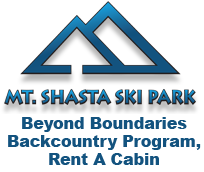The Mountain
MOUNTAIN OF FUN


GO LIVE
LAST 3 HOURS
LAST SNOW
Have awesome videos and pictures you'd like to share with our Park Team?
Send them to us using the form below.TWILIGHT SKIING
On Friday or Saturday we’ve created one of best night spots in town. Join your friends for twilight skiing and snowboarding fun. Watch a beautiful sunset over the Eddies while getting in a few more runs.
Be sure to visit Sliders Bar or one of our fabulous eateries.
Be sure to visit Sliders Bar or one of our fabulous eateries.
HOURLY OPERATION:
4 pm to 7 pm on Friday
4 pm to 6 pm on Saturday
The schedule allows you to ski and ride an additional 3 hours on Friday and 2 hours on Saturday.
Last Twilight Skiing Mid-March

SNOW MAKING
Mt Shasta Ski Park prides itself with an extensive snowmaking system which potentially can cover 277  acres out of a total of 425 acres with man-made snow. This installation helps to complement the natural snow cover during times when mother nature does not want to cooperate. Particularly in the beginning of the season an artificial snow layer makes a great base because the artificial snow crystals are denser thus making the snow last longer.
acres out of a total of 425 acres with man-made snow. This installation helps to complement the natural snow cover during times when mother nature does not want to cooperate. Particularly in the beginning of the season an artificial snow layer makes a great base because the artificial snow crystals are denser thus making the snow last longer.
 acres out of a total of 425 acres with man-made snow. This installation helps to complement the natural snow cover during times when mother nature does not want to cooperate. Particularly in the beginning of the season an artificial snow layer makes a great base because the artificial snow crystals are denser thus making the snow last longer.
acres out of a total of 425 acres with man-made snow. This installation helps to complement the natural snow cover during times when mother nature does not want to cooperate. Particularly in the beginning of the season an artificial snow layer makes a great base because the artificial snow crystals are denser thus making the snow last longer.
The secret to “blowing” snow from any of the Ski Park’s 19 snow guns is the combination of water under high pressure and cold air. The Ski Park has a water holding pond located uphill from the Marmot lift which holds 11 million gallons. This amount of water could cover 34 acres of slopes 1 foot deep with snow. It takes over 4 hours of snowmaking to cover approx ¾ acre 8 inches deep and it takes about 6 to 8 days of snow making to drain the pond. All that cold water is pumped by 4 large pumps with 550 psi of pressure through hundreds of feet of underground snow making pipe straight to the Ski Park’s 22 snow guns. Twenty of the snow guns are placed alongside the trail system served by the Marmot and Douglas chairs. Two snow guns are installed at the Super Pipe area on Upper Revolution run. Some of the snow guns are fixed but others are movable by snowcat.
The snow gun serves as the mixing chamber for the water and air. The mixture creates small water droplets under pressure, which are then forced out of the small gun nozzle into the air. When the mist of water droplets is released into the atmosphere’s lower pressure, it expands, releasing energy in the form of heat and “super cooling” the droplets, which then freeze as they drift to the ground. The temperatures must be at least 28 degrees to make quality snow. Wet Bulb Temperature is a temperature measurement that combines the ambient air temperature and the moisture content.

Water freezes at 32 degrees F, but in most cases, it’s not cold enough for snowmaking, even when the cooling effect of the compressed air is factored in. The moisture in the air is a key factor in successful snowmaking.
The adjustment of the air/water mixture, along with the selection and placement of the guns, is part of the process that constitutes the snowmaker’s art. Atmospheric conditions change constantly even between different areas of the Ski Park slopes.
Snowmaking crews are busy every minute of the night adjusting the air/water mixture in an effort to keep all the guns operating efficiently.
It is always a challenge to find the right temperature window. Particularly during inversion conditions snowmaking can be hindered because warm air is trapped on the ground prohibiting the operation of the snow guns.
At the Ski Park the snowmaking strategy is to make snow in the base area first before moving up the mountain. After piles of artificial snow are made at one location, the guns are moved to a new location and the snow cats start pushing the piles of snow. The piles are pushed to cover each run with a snow base of about 18″. The layers are then groomed two or three times to create a smooth, even snow surface for our guests to enjoy.
Snow making is indeed an art and a constant challenge, but when the conditions are right and the snow accumulates in big piles it is a rewarding experience for the Ski Park snow making crew!





No comments:
Post a Comment